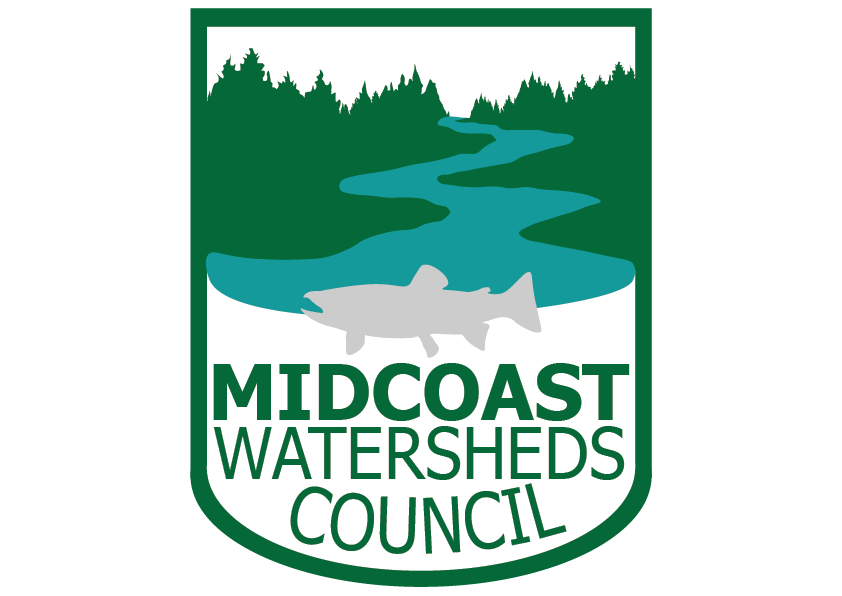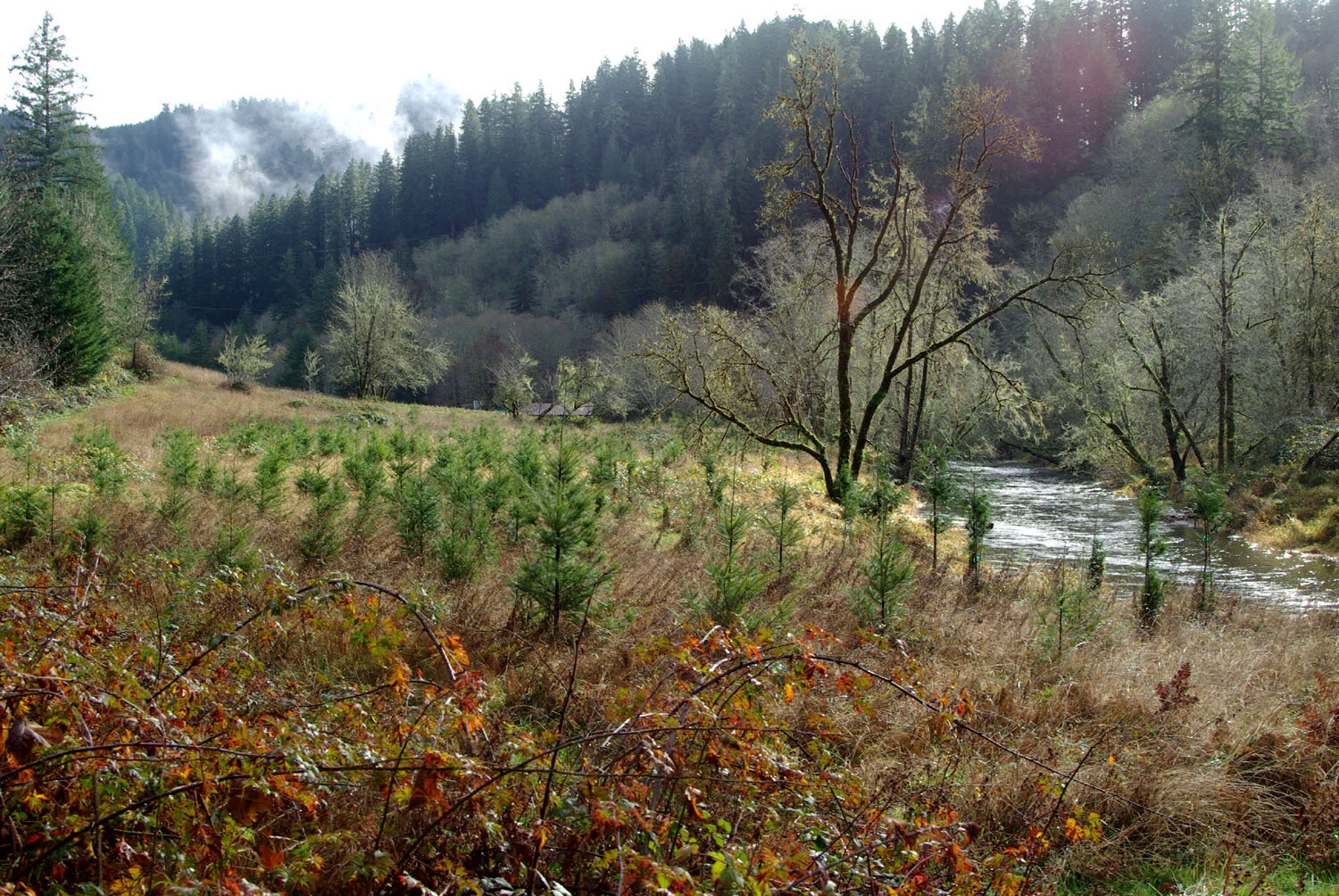The first restoration project under the FIP occurred in summer 2024, at The Wetland Conservancy’s Starr Creek Preserve, located along Alsea Bay. Restoration actions included removal of invasive plants, secure placement of large woody debris both instream and throughout the floodplain, and seeding/planting of native vegetation at appropriate elevations to restore tidal marsh, scrub/shrub, and spruce swamp habitats. These actions will improve tidal wetland habitat for coho and Chinook salmon, steelhead, and other fish and wildlife species, while also helping add resilience to climate change and sea level rise. More than 90% of forested tidal swamps have been lost from Oregon estuaries. Wood placed throughout this site will provide essential cover for fish and invertebrate species, protection from currents, and foraging opportunities, while also creating nurse logs and elevated platforms to support the growth of Stika spruce, Pacific crabapple, willow, and other scrub/shrub species. Logs placed instream will help collect sediment, slow and spread water over the floodplain, and could even encourage beaver to return to this site, coupled with establishment of enough native plants to support them.
Bayview Oxbow
The Bayview Oxbow is located on the northern end of Alsea Bay where historical tidal wetlands once thrived. Efforts to restore these wetlands have been in the works for years and aim to reconnect the oxbow with Alsea Bay so that water can flow over the natural floodplain once again. The Wetlands Conservancy, which owns most of the western portion of the Bayview Oxbow, completed preliminary designs for restoration at Bayview Oxbow in 2019 in coordination with adjacent landowners and other stakeholders.
Currently, these designs have been picked up by the Oregon Central Coast Estuary Collaborative (OCCEC) which will be conducting a thorough technical review of culvert removal and bridge replacement in coordination with Lincoln County and partners. The Bayview Oxbow has been identified by OCCEC as a Focused Investment Partnership (FIP) project site and will receive a holistic approach to reconnect the oxbow and address infrastructural concerns with the larger goal of increasing resilience to sea level rise and other climate change impacts.
The Bayview Oxbow used to consist of extensive tidal wetlands, with tidal flows traveling into the oxbow during high tide and flowing out during low tide. This regime has been dramatically altered by dikes, tidegates, and other infrastructure. There were also spots within the oxbow complex that have been identified as historical forested swamp habitat, a once abundant wetland type along the Oregon Coast. In the past 150 years of land use, these wetlands have been converted for agriculture and industry.
1939 aerial image of the Bayview Oxbow referenced in text below.
The earliest photos of the Bayview Oxbow from 1939 show the site already diked, ditched, and utilized by early settlers. Land use priorities have contributed significantly to the decline of wetland habitat along the Oregon Coast; tidal wetlands declining by an average of about 60% and forested and scrub-shrub swamp by an average of about 95% since European settlement. Addressing these massive changes in wetland composition along the Oregon Coast is necessary to restore natural ecosystem processes that have been deeply disturbed by human land use.
In the next few years, project partners expect to begin restoration actions in response to a comprehensive project design. Utilizing a variety of grant sources and collaboration with a host of partners, the Bayview Oxbow restoration project aims to reconnect the oxbow with the Alsea Bay, promoting wetland wildlife and generating community resilience to projected sea level rise in line with landowner interests and concerns.
Lint Slough
Lint Slough has been the site of Midcoast-involved restoration work since 1998 with goals of restoring tidal interaction with Alsea Bay. Since, Midcoast and partners have removed water controlling infrastructure, such as dikes and dams, restoring tidal access and promoting the establishment of historical wetland habitat.
The first restoration projects along the Lint Slough were motivated by the lasting impacts of a salmon rearing facility which proved a lasting barrier to tidal interaction even after it was discontinued in 1972. To restore the natural flow of Alsea Bay tides into the slough, Midcoast and partners removed various instream infrastructure that was left from the facility.
While early projects at this site succeeded in reconnecting historical wetland habitat and tidal influences, there still remain barriers to fish passage and even more habitat upstream to be reconnected.
While lower portions of the Lint Slough area have been restored, further opportunities exist upstream and are being explored by MidCoast and our partners in the Oregon Central Coast Estuary Collaborative (OCCEC) within the Focused Investment Partnership (FIP) “Restoring Resilience to Two Estuaries.” A majority of these upstream areas are ranked high or medium-high in MCWC's Landward Migration Zone study, making them targets for work now to build resilience to sea level rise and climate change, preparing them to be future tidal wetlands.
Early project partners include USFWS, ODFW, City of Waldport, and USFS.
Bummer Creek
Bummer Creek is located in the Alsea River watershed, and has been the target of numerous restoration projects since 2016. It was identified in an OWEB-funded Limiting Factors Analysis (LFA) as temperature and gravel limited. To address these issues, riparian planting, livestock exclusion fencing, culvert replacements and instream large woody debris placements have been implemented on a suite of 8 cooperating small private landowners within the basin.
Riparian plantings in protective cages with livestock fencing in background.
The LFA also classified the lower mainstem as highly incised and limited by reduced linkage to historical off channel rearing habitats. Both the USFWS and the MCWC have been instrumental in the development of salmonid accessible off channel wetland habitat in partnerships on the Parker property as part of this larger basin scale effort. LiDAR analysis has revealed the presence of 1.5 miles of diked and inaccessible oxbow habitat.
Map of channel alterations, wetland creation, and fencing on Bummer Creek.
We extended riparian fencing and planting downstream on Bummer Creek to the next 2 adjacent private land parcels (140 acres combined), reconfigured the wetland outlet to exit through its historical channel, and developed additional wetland habitats to store and retain winter runoff to address the summer temperature limitation in mainstem Bummer Creek.
This is a private landowner partnership with in-kind match contributed from Environmental Quality Incentives Program (EQUIP) and Conservation Reserve Enhancement Program (CREP). Funds supported the creation of approximately 1500 feet of livestock exclusion fencing on the Jackson property, putting 7.7 acres of land into riparian reserve in 2018.
Little Lobster Creek
Warm water temperatures are detrimental, and can be fatal to juvenile salmon. Little Lobster Creek in the Alsea Basin is known to reach unsuitable temperatures. A lack of fallen logs in the stream from the days of homesteading lead to a loss of salmon spawing gravel, since high flows washed the subrtrate away without something in the creek to hold it there. MCWC worked with volunteers and partners to create long term solutions to these problems.
Cedar being planted in grazing exclosure in the riparian area
MCWC and partners (including a team of volunteers) reestablished native conifers in the riparian area for long term shade and wood recruitment to the stream, and placed a significant amount of large wood within the channel to trap migrating substrate in the spawning grounds. The Siuslaw Collaborative Watershed Restoration Program and Oregon Watershed Enhancement Board funded the implementation of this work and the project management, and a large match was also secured from the BLM through donating wood used in the project.
Record Creek
Record Creek is a tributary to Swamp Creek, one of two major branches of the Bummer Creek sub-watershed within the greater South Fork Alsea system.
Riparian trees were historically cleared up to the stream, like many other areas in the Northwest. Eventually alders colonized the area, dominating the forest canopy and stalling later stages of forest from developing. While alders adequately provide the important function of shading the stream, their logs degrade quickly once fallen and do not contribute to creating the habitat complexity that fish and wildlife rely on to the degree that native conifers like Western red cedars do.
With funding from OWEB and log donations from BLM, in 2019 MCWC and placed 5 logjams over a 0.3 mile reach of Record Creek in order to trap and sort spawning gravel, form pools, and increase overall habitat complexity and floodplain connection. To provide an even longer term source of large woody debris to the stream, volunteers helped in planting 150 native Western red cedars in the alder-dominated riparian area of Record Creek. These trees will never be cut down, and will continue benefiting the habitat throughout their lifespan and beyond.
Ernest Creek
This project is located on the beautiful Thyme Garden property on Ernest Creek, a tributary of Crooked Creek in the Alsea River watershed which provides habitat for coho and Chinook salmon, cutthroat and steelhead trout, and lamprey species.
This project will improve stream complexity and riparian and aquatic habitat conditions by adding large wood structures and planting trees to supply wood for the stream long term. Current wood levels in the stream are significantly below ODFW recommended values, and has reduced complexity, floodplain connectivity, and increased channel erosion. Restoration work in 2002 reconnected Ernest Creek into its historical channel but experienced channel incision again because the lack of wood in the stream and soft, sandstone substrate.
MCWC and partners placed a total of 16 large wood structures on 0.7 stream miles, planted conifers on two acres of riparian habitat to increase potential for long term large wood recruitment, and . Project partners are Thyme Garden, another local landowner, Georgia Pacific, Northwest Oregon Restoration Partnership, and Bio-surveys LLC.









